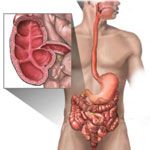Crohn’s disease is a chronic condition, but one that can be managed.
Crohn’s disease is an inflammatory condition that affects the gastrointestinal tract – the part of your digestive system where your body processes food and gets rid of waste. It includes the oesophagus, stomach, liver, intestines, and rectum. It’s a long-term medical problem that has no cure, and can affect any part of the digestive tract, from the mouth to the anus.
Crohn’s disease causes changes to happen in the wall of the bowel, which can vary from a mild irritation to a more severe state, where the layers of the bowel wall become thickened, ulcerated and ultimately deformed. This can cause serious complications, including obstruction of the bowel.
The disease occurs in attacks, so a person suffering from Crohn’s disease could feel well most of the time. Some people find that infections, such as the flu, or stress can bring on an attack.
Early symptoms of the disease include diarrhoea, abdominal pain and bloating.
Other symptoms can include:
- Tiredness;
- A feeling of fullness in the abdomen;
- Weight loss;
- Pain when going to the toilet;
- Blood or mucus in diarrhoea;
- Vomiting;
- Constipation; and
- Sores or ulcers around the anus.
Symptoms vary from person to person, as does the severity of the condition.
It is not known what causes Crohn’s disease, although it is possible that it’s caused by the immune system, a virus, or by environmental or diet factors.
The disease is diagnosed through a series of tests, including blood and stool (poo) tests, x-ray and an internal examination. Treatment can include medication or surgery. A change in diet, such as avoiding fatty or spicy foods, and vitamin supplements can also help.
|
Did You Know . . .? Most people with Crohn’s disease will have their first attack before their 30s, most commonly between the ages of 15 and 24. It’s estimated that about 10,000 people have Crohn’s disease in Australia. |

Comments are closed.